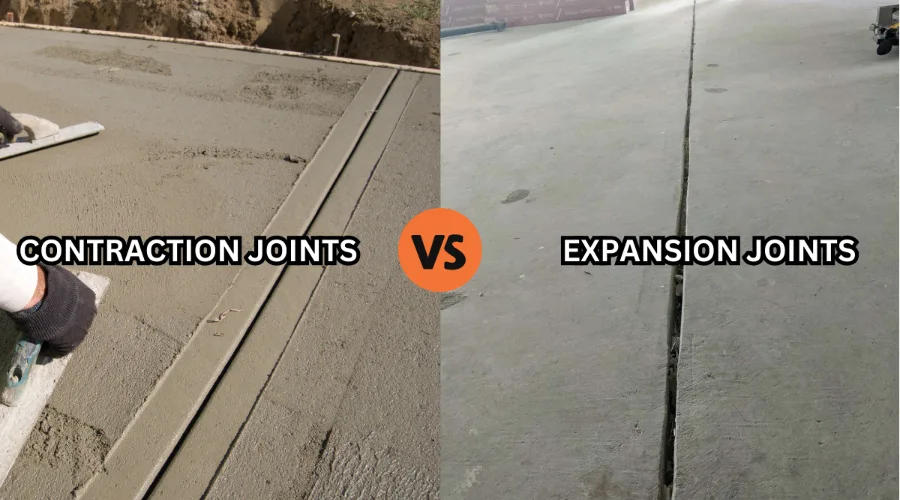Have you ever noticed the development of cracks in your concrete structure? What if we told you that cracks are a natural part of concrete’s life cycle? Since cracks have a direct association with concrete, they may be inevitable. This is where contraction joints come in. These joints help in controlling the occurrence of cracks, determining where the cracks should occur. Wondering what it is all about? This blog will help you understand the contraction joint in detail.
What is a Contraction Joint in Concrete?
A contraction joint is a pre-planned spacing or groove incorporated into the concrete slab or structure. It allows the anticipated shrinkage and movement of concrete, while curing and hardening. A slight concrete shrinkage occurs while drying due to moisture loss and temperature changes. At this stage, when the movement is restricted, it can develop cracks in random locations. A contraction joint steers these cracks into predetermined locations without compromising the structural integrity.
Purpose of Contraction Joints in Concrete
- Contraction joints control cracks caused by the natural shrinkage of concrete while it sets.
- These joints direct cracking areas and prevent random cracks that affect the strength of the structure.
- Contraction joints control the location of cracks and keep an uninterrupted concrete surface that is aesthetically pleasing.
- Properly installed contraction joints thus help retain the strength of concrete while preventing loss of strength due to uncontrolled cracking.
- These joints guard against premature damage, allowing the concrete to maintain its durability and usability over an extended period.
Types of Contraction Joints in Concrete
Saw-Cut Joints
Saw-cut joints are the joints formed by cutting the concrete surface using a saw after the concrete has initially set but before it is completely cured. Sawing produces clean, straight, and uniform joints, usually approximately 1/4th of the thickness of the slab. These joints can hold back cracks more efficiently, hence are preferable for larger-sized slabs.
Tooled Joints
Tooled joints are those formed by pressing a tool into the fresh concrete to obtain a groove. This process is usually done while the concrete is still in its plastic state. The tooling generates a smooth and well-defined groove conducive to shrinkage crack control. This method acts faster and can be done right after casting. They do not require any special equipment, which makes them suitable for small jobs only.
Formed Joints
A formed joint is accomplished by pre-made materials, such as joint inserts or plastic strips, being set in advance in formwork before the concrete pouring operation. These materials induce a predetermined groove in the slab once the concrete cures. Formed joints ensure equal depth and spacing, especially in large or industrial-scale works. They are most helpful for controlling cracking in long slabs uninterrupted by joints, such as highways or large floors.
How To Install Contraction Joints?
For placing concrete, a premolded strip can be inserted to create a spaced section of weakness. Metal strips inserted in terrazzo or preformed plastics have also been used in concrete pavements to avoid cracks.
Saw cut joints or dry cut joints can both be made after placing concrete.
- The saw-cut joint should be installed between 4 to 12 hours after finishing the concrete work.
- The dry-cut joint should be made between 1 and 4 hours after finishing work.
In this technique, joints are produced by using a hand groover or concrete saw, which involves cutting the concrete at regular intervals to create a weakened plane, which is then bonded well with concrete.
A saw joint can be formed as soon as the concrete has cured sufficiently, certainly before drying shrinkage begins to take place.
Prolonged exposure will cause unplanned cracking of the pavement, and the joint sealant is filled in the sawn joint to prevent debris from entering it, as unsealed joints tend to fill with dirt and become ineffective.
Applications of Contraction Joints in Construction
- These joints are mainly used in pavements and roads like highways, streets, and parking lots, where traffic and temperature fluctuations are crucial.
- They can be used for floors and slabs for warehouses, factories, residential and commercial spaces.
- They is essential for creating foundations in buildings or bridges, where moisture and temperature fluctuations are common.
- They are ideal for sidewalks and driveways in residential and commercial areas to prevent random cracking due to shrinkage.
Contraction Joints vs Expansion Joints

| Feature | Contraction Joints | Expansion Joints |
| Purpose | Contraction joints prevent cracks caused by concrete shrinkage. | Expansion joints allow movement due to temperature changes. |
| Function | It controls the size and location of cracks. | Allows structures to expand or contract freely. |
| Material Movement | Caused by concrete shrinkage | Caused by temperature changes that influence expansion and contraction. |
| Placement | These joints are placed in slabs, pavements, floors, sidewalks, and driveways. | These joints are used in bridges, buildings, roads, highways, and large buildings. |
| Design | They are designed to fit narrow gaps and require no filler. | It is designed for wider gaps, and is filled with flexible materials. |
| Main Effect | It helps in preventing random cracking. | It helps in accommodating thermal movements and the shifting of buildings. |
| Appearance | These joints are visible as small, controlled gaps. | These joints are larger and often sealed with flexible material. |
Conclusion
Although contraction joints may be seemingly small, they are very important for a crack-free concrete surface and durability. They are used effectively in sidewalks as well as foundations. Understanding their importance and functions distinguishes proper concrete construction. Proper installation and maintenance will guarantee that the concrete serves effectively for a long time in terms of strength, durability, and aesthetics. Ensure correct installation now, to avoid issues later.

